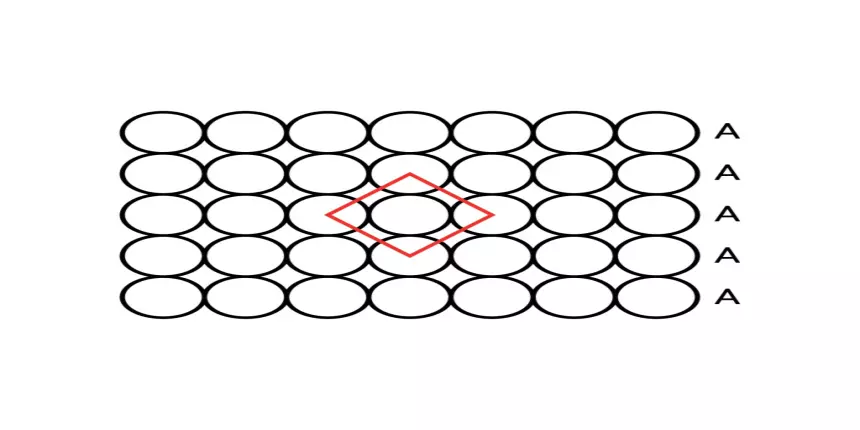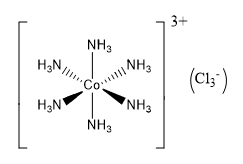JEE Main Important Physics formulas
ApplyAs per latest 2024 syllabus. Physics formulas, equations, & laws of class 11 & 12th chapters
Coordination Number Definition - Transitional elements/metals (mainly the d-block elements) in chemistry give rise to a vast number of complex compounds in which metal atoms are bonded to numerous anions (negatively charged ions) or neutral molecules. such compounds are called Coordination compounds. The coordination number is one of the most basic notions in Coordination Compound Chemistry. Ligands are ions (charged) or molecules (neutral) attached to the coordination compound's center atom/ion.

Also, check-
Do you know how to define the Coordination number? it is defined as the total number of atoms, ions, or molecules attached to an atom in a specific molecule or crystal and is referred to as the coordination number of that atom. The coordination number of an atom is often referred to as its ligancy.
The ligands are the atoms, ions, or molecules that are attached to the center atom (or molecule/ion). When computing the coordination number of a central atom in a crystal, the ligancy of molecules is computed differently.
According to the radius ratio, “The larger the charge, the smaller the ion becomes, limiting the number of groups that can coordinate.”
Different types of forces hold the atoms together in these complexes and contribute to the observed coordination numbers. In fluoride complexes, the bonds to the extremely electronegative fluorine atoms are virtually ionic. Therefore increase in coordination number with fluoride ion of 4 to 6 to 7 for B3+, Fe3+, and Zr4+ is primarily due to the cation's increased size. This allows a growing number of fluoride ions to be packed around the center ion.
Also read :
The coordination number related to a given atom in polyatomic ions and molecules can be computed by counting the total number of atoms, it is bound. whether it is a single bond or a double/triple bond all are included to calculate coordination number. Using the polyatomic ion [Cr(NH3)2Cl2Br2]– as an example, the coordination number of the core cation (Cr3+) can be calculated by counting the total number of atoms linked to the chromium atom, which is 6. this means coordination number is 6.

Because the center cobalt atom is connected to six different nitrogen atoms in the example above, the coordination number of the central cobalt atom is six. The bonds between crystals are less obvious in their solid state forms. In such cases, the coordination number of the center atom reflects the sum arrangement of neutrons around the atom in question. The total number of atoms that surround a specific atom in a crystal is determined by the atom's position in the crystal. In the case of crystals, there are two separate metrics of ligancy- the bulk coordination number and the surface coordination number. Also, students can find related topics below.
A coordination number of a crystalline solid is the number of atoms, ions, or molecules that a central atom/ion has as its nearest neighbors. For example, the coordination numbers of Pt and Fe in the complex ions [PtCl6]2– and [Fe(H2O)6]2+ are 6 and 6, respectively. Pt and Fe are linked to six ligands, Cl and H2O, respectively.
[Cr(NH3)2Cl2Br2]– is another example. Because the total number of atoms/ions/molecules linked to Cr is discovered to be 6, the core atom Cr has coordination number 6. Bidentate ligand, the coordination number Co is 6 in the complex ion [Co(en)3 ]3+. Below students can find coordination numbers with some examples.
[Ag(NH3)2]+, where Ag has a coordination number of 2 and the compound's molecular shape is linear.
[NiCl4]2, where Ni has a coordination number of 4 and the compound's molecular shape is square planar.
[CoCl6]3 is a chemical with the coordination number 6 and an octahedral molecular shape.
The molecular geometry of [ZrF7]3 is a pentagonal bipyramid, with Zr having coordination number 7.
[CoCl5]2 is a chemical with the coordination number 5 and a trigonal bipyramidal molecular shape.
We can calculate the geometry of a molecule using the coordination number. A list is given below with the corresponding geometry and coordination number.
Coordination number | Molecular Geometry |
2 | Linear |
3 | Trigonal Planar |
3 | T-shaped |
3 | Trigonal Pyramidal |
4 | Tetrahedral |
4 | Square Planar |
5 | Trigonal Bipyramidal |
5 | Square Pyramid |
6 | Octahedral |
7 | Pentagonal Bipyramidal |
7 | Capped Octahedron |
8 | Square Antiprism |
8 | Dodecahedron |
8 | Hexagonal Bipyramidal |
9 and above | Other complex structures like cuboctah |
NCERT Chemistry Notes :
There are different type of lattice like BCC, FCC, and many more. The abbreviation for BCC is body centered cubic and The coordination number of bcc atom is 8. the abbreviated of FCC is Face centered cell and the coordination number is 12. The abbreviation of CCP stands for cubic close-packed and coordination number is 12. Similarly, hcp stands for hexagonal close-packed cell and the coordination number of hcp is 12. The coordination number of simple cubic seems to have a coordination number of 6 and each unit cell contains one atom.
Also, Refer To
There are multiple factors that affect the coordination number like the charge which depends on the electromagnetic configuration of the metal ion, the size of the metal ion, and many more.
A coordination number is a number of legends bounded by central metal. For example, in the given compound [Cr(NH3)2Cl2Br2]−, Cr3+ is a central atom that has six legends bounded with it therefore the coordination number is 6 and the compound is described as a hexacoordinate.
the metal ion plays an important role and the larger the metal ion, the more ligands can fit around it and number of legends is called the coordination number thus higher the size of the metal ion more the coordination number is.
the coordination number depends on the structure of the metal as the larger the size of metal more the legends. as well as it depends on the charge on the metal.
A unit cell is the smallest repeating unit that has full symmetry of the crystal structure and it is defined as a parallelepiped, with the six lattice parameters taken as the lengths of the cell edges (a, b, c) and the angles between them (α, β, γ).
There are some examples of coordination number
[Ag(NH3)2]+, where Ag has a coordination number of 2 and the compound's molecular shape is linear.
[NiCl4]2, where Ni has a coordination number of 4 and the compound's molecular shape is square planar.
[CoCl6]3 is a chemical with the coordination number 6 and an octahedral molecular shape.
The coordination number means a number of atoms surrounded by a central atom. Coordination number of 5 means the central ion is surrounded by 5 molecules or legends.
Apr 27, 2022 - 12:42 p.m. IST ---STATIC
Apr 27, 2022 - 12:42 p.m. IST ---STATIC
Apr 27, 2022 - 12:42 p.m. IST ---STATIC

As per latest 2024 syllabus. Physics formulas, equations, & laws of class 11 & 12th chapters

Get up to 90% scholarship on NEET, JEE & Foundation courses

As per latest 2024 syllabus. Chemistry formulas, equations, & laws of class 11 & 12th chapters

Enrol in PACE IIT & Medical, Financial District, Hyd for JEE/NEET preparation

Start your JEE preparation with ALLEN

Ace your NEET preparation with ALLEN Online Programs